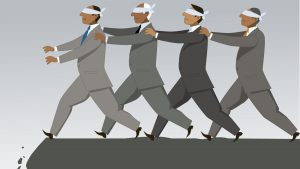
Sasson with the first digital camera
Last week, I had come across an extremely interesting blog post published by the Harvard Business Review and written by Scott Anthony discussing the failure of photography giant Kodak. At one point, Kodak was one of the most powerful companies in the world, dominating the camera market during the era of film. As such, it is hard to believe that the company filed for bankruptcy protection in 2012 to soon sell of its patents in order to liquidate. How exactly could this have happened?
Anthony describes their failure simply as “myopia”, the company failed to adapt to the changing market and was blinded by their success (1). In COMM 292, we had discussed the judgement shortcut of overconfidence bias: the tendency to be “overconfident about our abilities” (2). In Kodak’s case, the large amount of overconfidence bias that their management was evident. Steve Sasson, an engineer who once worked at Kodak was the inventor of the first digital camera prototype. He presented management with his product, which then prompted management to invest billions into developing a range of digital cameras. However, the shortsighted management was so concerned about matching the performance of their current film cameras instead of “embracing the simplicity of digital” (1).
Simply put, Kodak had analyzed the situation partially correct, by investing into a product that would eventually displace film cameras. However, they were unaware of their overconfidence in their current product, as they attempted to match their film cameras’ performance. This led to them producing a sub-optimal product and losing millions of dollars. Eventually, Kodak’s inability to fully adapt to the digital market led to their demise.
This does leave an important lesson for future companies regarding overconfidence and shortsightedness. While basing your change on future technologies, one should be able to approach the situation in a new light. Essentially, such as in the Four D’s of Appreciative Inquiry, companies should visualize “what might be”. It simply is not good enough to grab a new idea and add it onto a preexisting success, there must be more thought behind the process of change.
- Langton, Robbins, Judge, Organizational Behaviour, 7th edition, p. 419.
- Anthony, Scott. “Kodak’s Downfall Wasn’t About Technology.” Harvard Business Review. N.p., 20 Mar. 2017. Web. 02 Apr. 2017.












